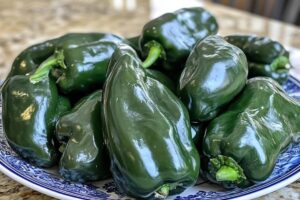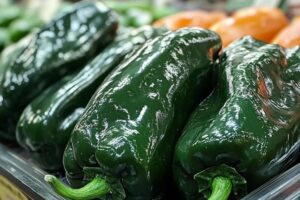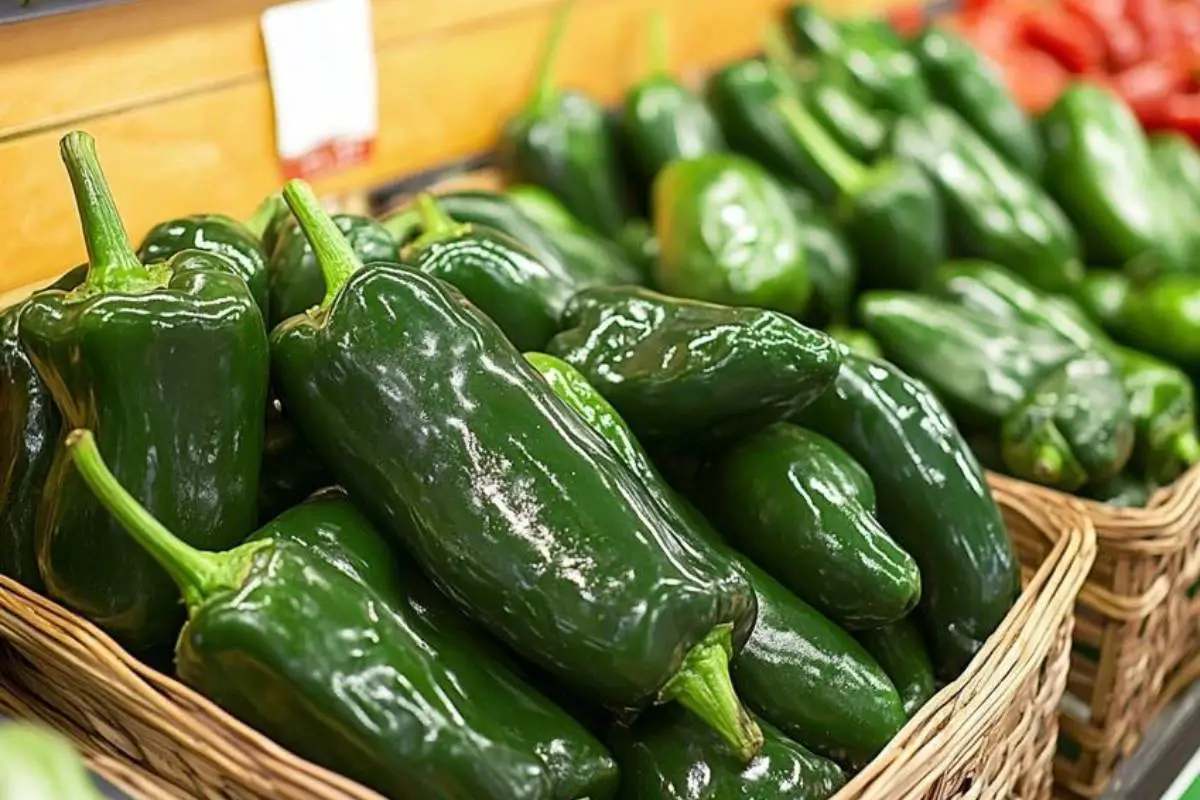Poblano peppers are a staple ingredient in many Mexican dishes, prized for their mild heat and earthy, smoky flavor. Whether you’re grilling, roasting, or stuffing them, you’ve probably encountered the question: Do you have to remove the skin from poblano peppers? The answer depends largely on how you plan to use the peppers in your recipe.
While the skin of a poblano pepper is technically edible, it often becomes tough and chewy after roasting or grilling. Many cooks recommend peeling the skin, particularly if you’re aiming for a smooth, creamy texture in dishes like salsas, soups, or stuffed peppers. For a deeper dive into the techniques for removing pepper skins, check out this guide to roasting peppers.
On the other hand, some recipes benefit from the extra flavor that charred pepper skins provide. The choice between peeling or leaving the skin on comes down to the specific dish you’re preparing. If you’re curious about the nutritional benefits of poblano peppers, explore the health benefits of peppers in general in Health Benefits of Peppers.
What is the Skin of Poblano Peppers?
The skin of poblano peppers is thicker than that of many other peppers, such as bell peppers or jalapeños. This waxy layer becomes charred and slightly tough when exposed to high heat, like grilling or roasting. While the smoky flavor from charred skin is delicious in some recipes, the texture can be undesirable, particularly in smooth dishes.
In comparison to thinner-skinned peppers, poblano peppers offer a more noticeable texture when the skin is left on. This characteristic leads many cooks to remove the skin in recipes where texture matters. However, the decision to peel depends largely on the preparation method and the intended use of the peppers.
Why You Might Want to Remove the Skin from Poblano Peppers
Here are a few reasons why many recipes call for removing the skin from poblano peppers:
- Texture: The primary reason to remove the skin is to improve the texture of your dish. Roasted poblano skin can be tough and unpleasant in creamy dishes like soups or salsas. Removing the skin creates a smoother, more consistent texture.
- Consistency: In blended recipes like poblano sauces or queso dip, the skin can cause a gritty or uneven consistency. Peeling the peppers ensures a silky finish.
- Presentation: Removing the skin creates a cleaner, more polished appearance. Dishes like stuffed poblano peppers or enchiladas benefit from the smooth, skinless look of the peppers.
If you’re aiming for a smooth, creamy texture or a polished presentation, it’s worth the extra step to peel the peppers. However, if you’re making a rustic dish where texture isn’t as important, you might leave the skin on for its charred flavor.
When Can You Leave the Skin On?
While many recipes benefit from peeling poblano peppers, there are situations where leaving the skin on works just as well:
- Grilled or Charred Dishes: Recipes that rely on the smoky flavor of grilled or charred poblanos often keep the skin intact. Dishes like fire-roasted salsas or grilled pepper salads benefit from the deep flavor the skin provides.
- Rustic Dishes: If you’re making a hearty, rustic dish where texture plays a less important role, leaving the skin on adds a rich, smoky flavor. Recipes like roasted vegetable medleys or charred poblanos with beans work well with the skin left on.
- Personal Preference: Some people enjoy the slight chew and smoky notes the skin adds to certain dishes. In these cases, leaving the skin on is entirely acceptable.
For casual home-cooked meals or grilled dishes where texture isn’t a primary concern, leaving the skin on can save time while enhancing the flavor.
How to Remove the Skin from Poblano Peppers

When you decide to remove the skin, the most common method involves roasting the peppers. Roasting softens the flesh and makes the skin easier to peel. Here’s a step-by-step guide to peeling poblano peppers:
1. Roast the Peppers:
- Preheat the oven to 400°F or heat a grill to medium-high.
- Place the whole peppers on a baking sheet (for oven roasting) or directly over the grill flames.
- Roast for 10-15 minutes, turning occasionally, until the skin blisters and blackens on all sides.
2. Steam the Peppers:
- After roasting, transfer the peppers to a bowl and cover with plastic wrap, or place them in a sealed plastic bag. This helps trap steam, which loosens the skin.
- Let the peppers steam for 10-15 minutes to make peeling easier.
3. Peel the Skin:
- Once the peppers have cooled slightly, use your fingers or a paper towel to rub off the skin. The skin should peel away easily. If needed, you can rinse the peppers under cool water while peeling.
4. Remove the Seeds (Optional):
- If desired, cut the peppers open and remove the seeds. This step also helps reduce the heat, as the seeds contain most of the pepper’s spiciness.
This method ensures that your peppers have a soft, smooth texture without the tough, chewy skin. It’s particularly useful for dishes like stuffed poblanos, soups, or creamy sauces.
How Does Removing the Skin Affect Flavor and Texture?
Peeling poblano peppers primarily affects the texture rather than the flavor. The roasted skin tends to be slightly tough and chewy, which can disrupt the texture of dishes that require a smooth finish. By removing the skin, you create a pepper that is soft, tender, and more suitable for blending into soups, salsas, and queso dips.
As for the flavor, removing the skin doesn’t drastically change the taste of the pepper itself. The flesh still retains its earthy, mild heat and slightly smoky flavor. However, leaving the skin on can introduce a deeper, charred flavor that adds complexity to grilled or roasted dishes.
Popular Recipes That Call for Skinless Poblano Peppers

Several recipes benefit from peeling poblano peppers, especially those that require a smooth or creamy consistency. Some popular options include:
- Stuffed Poblano Peppers: Peeling the skin ensures that the stuffed peppers have a smooth, tender texture, especially after baking.
- Roasted Poblano Soup: This creamy soup becomes velvety when the peppers are peeled, preventing any chunks or pieces of skin from disrupting the texture.
- Poblano Salsa: For a smooth salsa, removing the skin helps achieve a consistent texture that blends well with tomatoes, onions, and garlic.
- Poblano Queso Dip: Peeling the poblanos ensures a silky, creamy dip that pairs perfectly with chips or as a topping for tacos.
Nutritional Benefits of Poblano Peppers
Poblano peppers not only offer a rich, smoky flavor to various dishes, but they also provide a wide range of nutritional benefits that make them a healthy addition to your diet. Whether you roast, grill, or stuff them, these mild peppers are packed with vitamins, minerals, and antioxidants. Let’s take a closer look at why you should consider adding poblano peppers to your meals.
1. Low in Calories
One of the standout benefits of poblano peppers is that they are very low in calories. A medium-sized pepper contains approximately 30-50 calories, making them a great option for those looking to add flavor without adding extra calories.
- Calories per medium poblano pepper: 30-50
- Perfect for adding volume to meals without increasing the calorie count.
2. Rich in Vitamins A and C
Poblano peppers are an excellent source of vitamin A and vitamin C, two essential nutrients that play a crucial role in maintaining overall health.
- Vitamin A: Supports eye health, boosts the immune system, and promotes healthy skin. Poblano peppers contain 10% of the recommended daily intake of vitamin A per serving.
- Vitamin C: Acts as a powerful antioxidant, protecting your cells from oxidative stress and helping your body fight off infections. One poblano pepper provides around 95 milligrams of vitamin C, covering more than 150% of the daily recommended intake.
Both vitamins are crucial for maintaining a strong immune system and promoting skin health.
3. High in Fiber
Poblano peppers are a good source of dietary fiber, which is essential for maintaining digestive health and keeping your gut regular. Fiber not only supports healthy digestion but also helps to:
- Improve satiety: Fiber helps you feel full for longer, reducing the chances of overeating or snacking between meals.
- Lower cholesterol levels: Fiber can help to reduce cholesterol levels, supporting heart health.
A medium poblano pepper provides about 2 grams of fiber, contributing to the recommended daily intake of 25-30 grams for adults.
4. Rich in Antioxidants
In addition to vitamins A and C, poblano peppers contain a variety of antioxidants that protect the body from free radical damage, which can lead to inflammation and chronic diseases.
- Beta-carotene: A precursor to vitamin A, beta-carotene acts as an antioxidant that supports vision and skin health.
- Capsaicin: Though poblanos are milder compared to other peppers, they still contain small amounts of capsaicin, a compound known for its anti-inflammatory properties. Capsaicin is linked to reduced pain and inflammation, as well as improved cardiovascular health.
These antioxidants are key players in promoting overall health and preventing oxidative damage to cells.
5. Good Source of Minerals
Poblano peppers provide essential minerals that are important for maintaining bodily functions. Some of the key minerals found in poblanos include:
- Potassium: Aids in regulating blood pressure and maintaining electrolyte balance. Consuming foods rich in potassium, like poblano peppers, can help reduce the risk of heart disease.
- Iron: While not high in iron, poblano peppers can help with iron absorption due to their high vitamin C content. This makes them a useful addition to meals that include iron-rich foods.
6. Supports Weight Management
Thanks to their low calorie count and high fiber content, poblano peppers are an excellent food choice for those looking to manage their weight. The fiber keeps you feeling full, reducing hunger and the likelihood of overeating. Plus, their versatility allows you to include them in a wide variety of dishes without adding excess calories or fat.
- Low in calories, high in nutrients: Poblano peppers are nutrient-dense, offering essential vitamins and minerals without unnecessary calories.
7. Helps Regulate Blood Sugar
The fiber content in poblano peppers can also help regulate blood sugar levels. Fiber slows down the absorption of sugar in the bloodstream, making it easier to keep blood sugar levels stable, which is especially beneficial for those with type 2 diabetes or anyone looking to manage their blood sugar.
Final Thoughts on the Nutritional Benefits of Poblano Peppers
Poblano peppers are not only delicious but also pack a strong nutritional punch. They are low in calories and rich in essential vitamins, minerals, fiber, and antioxidants, all of which contribute to better health. Whether you’re roasting, grilling, or stuffing them, poblano peppers offer a flavorful and healthy addition to your meals.
By including poblano peppers in your diet, you’ll be boosting your intake of vital nutrients that support immune health, digestion, heart function, and more. Plus, their versatility makes them an easy and tasty ingredient to incorporate into a variety of dishes.
FAQs
Can you eat the skin of poblano peppers?
Yes, the skin is edible. However, after roasting, it becomes tough and may affect the texture of certain dishes. Many cooks recommend peeling it for smoother recipes.
Do you have to remove the skin for salsa?
It’s not required, but removing the skin can result in a smoother salsa. Leaving the skin on adds a smoky flavor, which works well in rustic salsas.
Is the skin hard to digest?
For some people, the skin can be difficult to digest, especially if it isn’t fully cooked. Peeling the peppers can make them easier on the stomach.
Do you need to remove the seeds as well?
Removing the seeds is optional. The seeds are where most of the pepper’s heat comes from, so if you prefer a milder flavor, it’s a good idea to remove them along with the skin.

Conclusion
Deciding whether to remove the skin from poblano peppers depends largely on the dish you’re preparing and your personal preferences. If you’re looking for a smooth texture in soups, salsas, or quesos, peeling the skin is recommended. However, if you’re after a charred, smoky flavor in grilled or rustic dishes, leaving the skin on can add depth to your recipe.
By understanding how the skin affects both texture and flavor, you’ll be better equipped to make the right choice for your next dish. Whether you decide to peel or not, poblano peppers will continue to add a delicious, nutrient-packed punch to your meals.

